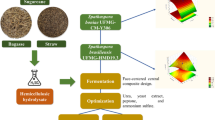Abstract
Cork taint, one of the most known off-flavours in wine, is usually attributed to the presence of the aromatic compound 2,4,6-trichloroanisole (2,4,6-TCA) in cork stoppers made from the bark of the cork oak, Quercus suber. There are many major chemical/biochemical pathways through which 2,4,6-TCA can be formed during cork production. The estimated incidence of cork-tainted wine bottles ranges from 2–to 7%, costing global wine industry approximately US$ 10 billion annually. During this study, a laboratory-scale system was designed and constructed, to efficiently treat cork bark and stopper samples using ozone and/or other sterilizing gases, such as steam, via sequential application of pulsed vacuum–pressure cycles. The developed physicochemical processes were studied and evaluated in order to achieve both sterilization conditions and 2,4,6-TCA removal without affecting the mechanical and bottling properties of cork. According to the results, the application of ozone alone seems to be a promising treatment method for cork barks. However, the pulsed treatment ensures both sufficient removal (99%) of both bacteria and moulds from cork stoppers when combined with ozone or steam and satisfactory deodorization of cork stoppers achieving high percentages (90%) of 2,4,6-TCA removal when combined with steam. The operating cost of each alternative process (plain or pulsed, with or without ozone and/or steam) was estimated and compared, in laboratory scale, for the selection of the most efficient process, taking into account technicoeconomical aspects.












Similar content being viewed by others
References
Gibson LJ, Easterling KE, Ashby MF (1980) Proc R Soc Lond Ser A 377:99–117
Silva Pereira C, Figueiredo Marques JJ, San Romão MV (2000) Crit Rev Microbiol 26(3):147–162
http://www.corkqc.com/cqcpro.htm, Cork Quality Council Forestville CA, 707-887-0141
Buser HR, Zanier C, Tanner H (1982) J Agric Food Chem 30:359–362
http://en.wikipedia.org/wiki/Cork_taint, Wikipedia, The free encyclopedia
QUERCUS (1996) Qualitative Experiments to Determine the Components Responsible and Eliminate the Causes of Undesirable Sensory Characteristics in Drinks Stoppered With Cork, European Union and C. E. Lieges contract No. AIR1-CT92-0372
Amon JM, Vandepeer JM, Simpson RF (1989) Aust NZ Wine Ind J 4(1):62–69
Andrew L, Waterhouse and UCD Students of Natural Products of Wine, VEN 219, Viticulture & Enology, UC Davis, 2001, http://waterhouse.ucdavis.edu/ven219/index.htm
Mazzeoleni V, Caldenty P, Careri M, Mangia A, Calagrande O (1994) Am J Vitic Enol 45(4):401–406
Hervé E, Price S, Burns G, Weber P (2000) http://www.corkqc.com/asev/asev2-2.htm
Tanner H, Zanier C, Buser HR (1981) Schweiz Z Obst Weinbau 117:97–103
Liacopoulos D, Barker D, Howland PR, Alcorso DC, Pollnitz AP, Skouroumounis GK, Pardon KH, McLean HJ, Gawel R, Sefton MA (1999) In: Blair RJ, Sas AN, Hayes PF, Høj PB (eds) Proceedings of the 10th Australian wine industry technical conference, Sydney, pp 224–226
Peña Neira A, Fernández de Simón B, García Vallejo MC, Hernández T, Cadahía E, Suarez JA (2000) Eur Food Res Technol 211:257–261
Heyes N (1995) In: Leske PA, Egligton JM (eds) Proceedings ASVO enology seminar corks and closures. Australian Society of Viticulture and Enology, Adelaide, pp 9–10, 28
Lee TH, Simpson RF (1993) In: Fleet GH (ed) Wine microbiology and biotechnology. Harwood, Chur, Switzerland, pp. 353–372
Leske PA, Bruer NGC, Sefton MA (1995) In: Leske PA, Egligton JM (eds) Proceedings ASVO enology seminar corks and closures. Australian Society of Viticulture and Enology, Adelaide, pp 24–26
Fuller P (1995) Aust NZ Wine Ind J 10:58–60
Barker DA, Capone DL, Pollnitz AP, McLean HJ, Francis IL, Oakey H, Sefton MA (2001) Aust J Grape Wine Res 7:40–46
Jackson RS (1994) Wine science: principles and applications. Academic Press, San Diego, pp 311–320
Hill JL, Hocking AD, Whitfield FB (1995) Food Chem 54:161
Juanola R, Subirà D, Salvadó V, Garcia Regueiro JA, Anticó E (2005) Eur Food Res Technol 220:347–352
Whitfield F (1998) Int J Food Sci Technol 33:31–51
Butzke C, Evans TJ, Ebeler SE (1998) In: Waterhouse AL, Ebeler SE (eds) Chemistry of wine flavour, ACS symposium series 714. American Chemical Society, Washington, DC, pp 208–216
International Standard 10718 Cork stoppers–enumeration of colony-forming units of yeasts, moulds and bacteria capable of growth in an alcoholic medium, Second Edition 2002-08-01, Reference number IS0 10718:2002(E)
Vlachos P, Kampioti A, Kornaros M, Lyberatos G (2005) In Congress: The 4th international conference on instrumental methods of analysis: modern trends and applications, Iraklion Crete, Greece
Vlachos P, Kampioti A, Kornaros M, Lyberatos G (2005) In congress: off-flavours: musty taint in wine and other beverages, Tarragona, Spain
http://stpats.com/corkproduction.htm (2004)
Alvarez-Rodriguez ML, Lopez-Ocana L, Lopez-Coronado JM, Rodriguez E, Martinez MJ, Larriba G, Coque JJR (2002) Appl Environ Microbiol 68:5860–5869
Juanola R, Subirà D, Salvadó V, Garcia Regueiro JA, Anticó E (2002) J Chromatogr A 953:207–214
Howland PR, Pollnitz AP, Liacopoulos D, McLean HJ, Sefton MA (1997) Aust J Grape Wine Res 3:146–152
Hoffmann A, Sponholz W (1997) Am Lab 29(7):22
Guzel-Seydima ZB, Greeneb AK, Seydima AC (2004) Lebensm Wiss u Technol 37:453–460
Rosa Shows Promise, Bark to bottle, Issue 14, May 2003, www.corkfacts.com/publications/2003may14.htm
International Code of Cork Stoppers manufacture Practices–CELIEGE—5th version 2006
Acknowledgements
This work has been supported by the EU “Quality of Life and Management of Living Resources” program: “Innovation in the process of cork production for the elimination of odours responsible for cork taint”, INNOCUOUS project (QLK1-CT-2002-01678).
Author information
Authors and Affiliations
Corresponding author
Rights and permissions
About this article
Cite this article
Vlachos, P., Kampioti, A., Kornaros, M. et al. Development and evaluation of alternative processes for sterilization and deodorization of cork barks and natural cork stoppers. Eur Food Res Technol 225, 653–663 (2007). https://doi.org/10.1007/s00217-006-0461-3
Received:
Revised:
Accepted:
Published:
Issue Date:
DOI: https://doi.org/10.1007/s00217-006-0461-3




